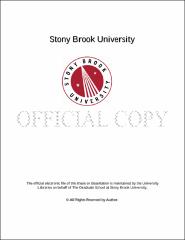| dc.identifier.uri | http://hdl.handle.net/11401/76560 | |
| dc.description.sponsorship | This work is sponsored by the Stony Brook University Graduate School in compliance with the requirements for completion of degree. | en_US |
| dc.format | Monograph | |
| dc.format.medium | Electronic Resource | en_US |
| dc.language.iso | en_US | |
| dc.publisher | The Graduate School, Stony Brook University: Stony Brook, NY. | |
| dc.type | Dissertation | |
| dcterms.abstract | In the first part of this dissertation research, an extension of the binomial tree model to a regime-switching volatility model in a two-state setting for volatility is derived, analyzed and tested. A dynamic programming method for mean-variance hedging is applied to price European option value. After convergence and simulation study, we demonstrate that an HMM driven stochastic volatility process will converge to a geometric brownian motion with a constant volatility. In the second part, we further incorporate an autoregressive component into the regime switching model based on observations of the first part and derive an autoregressive regime-switching model for financial time series data. A parsimonious estimation method of autoregressive regime-switching model is developed using Gram-Schmidt orthogonalization, Frobenius norm minimization, and the EM algorithm. The positive semi-definite correlation matrix issue is considered and addressed in our estimation method. Stability and accuracy is also examined in part two. In the third part, observations based on the analysis of real financial time series are shown. The integrated, fractional integrated and heavy tail feature of non-stationary time series is studied. Estimation, forecasting and backtesting are performed with ARMA-GARCH, FARIMA-FIGARCH and our autoregressive regime-switching model. In comparison with other models, autoregressive regime-switching model has better backtesting results for forecasting VaR models with high frequency financial time series. | |
| dcterms.available | 2017-09-20T16:50:38Z | |
| dcterms.contributor | Frey, Robert | en_US |
| dcterms.contributor | Mullhaupt, Andrew | en_US |
| dcterms.contributor | Rachev, Svetlozar | en_US |
| dcterms.contributor | Holod, Dmytro | en_US |
| dcterms.contributor | Smith, Noah. | en_US |
| dcterms.creator | Zhang, Xiaochu | |
| dcterms.dateAccepted | 2017-09-20T16:50:38Z | |
| dcterms.dateSubmitted | 2017-09-20T16:50:38Z | |
| dcterms.description | Department of Applied Mathematics and Statistics. | en_US |
| dcterms.extent | 119 pg. | en_US |
| dcterms.format | Application/PDF | en_US |
| dcterms.format | Monograph | |
| dcterms.identifier | http://hdl.handle.net/11401/76560 | |
| dcterms.issued | 2015-08-01 | |
| dcterms.language | en_US | |
| dcterms.provenance | Made available in DSpace on 2017-09-20T16:50:38Z (GMT). No. of bitstreams: 1
Zhang_grad.sunysb_0771E_11177.pdf: 624052 bytes, checksum: 432c7c8b10f2c0a9072780564ab414f4 (MD5)
Previous issue date: 2012 | en |
| dcterms.publisher | The Graduate School, Stony Brook University: Stony Brook, NY. | |
| dcterms.subject | Applied mathematics | |
| dcterms.title | A New Regime-Switching Model for Financial Time Series | |
| dcterms.type | Dissertation | |

